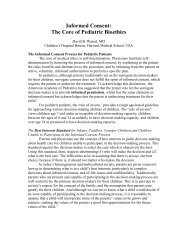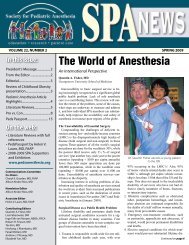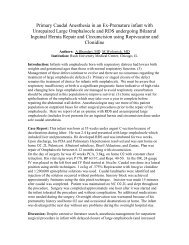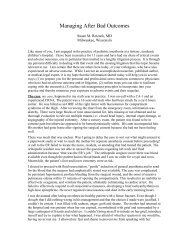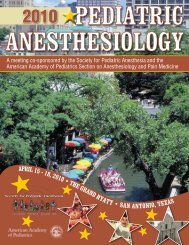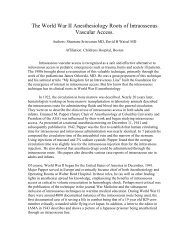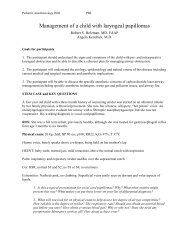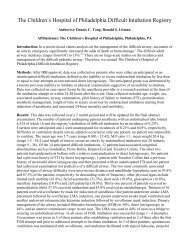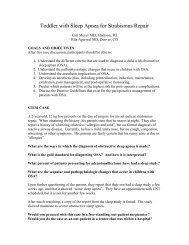The emergency department wants to use Etomidate for sedation ...
The emergency department wants to use Etomidate for sedation ...
The emergency department wants to use Etomidate for sedation ...
Create successful ePaper yourself
Turn your PDF publications into a flip-book with our unique Google optimized e-Paper software.
Pediatric Anesthesiology 2006PBL<strong>The</strong> <strong>emergency</strong> <strong>department</strong> <strong>wants</strong> <strong>to</strong> <strong>use</strong> E<strong>to</strong>midate <strong>for</strong> <strong>sedation</strong>:Should we let them?Jeffrey L. Galinkin MD, FAAP<strong>The</strong> Children's Hospital, DenverJeana E. Havidich MDMedical University of South CarolinaObjectives:1. Understand the role of anesthesia <strong>department</strong>s in hospital <strong>sedation</strong> committees and currentnational <strong>sedation</strong> guidelines.2. Discuss the utility or lack of utility of capnography and the BIS moni<strong>to</strong>r <strong>for</strong> <strong>sedation</strong> outside ofthe operating room.3. Develop a group consensus on the <strong>use</strong> of E<strong>to</strong>midate by non-anesthesiologist <strong>for</strong> <strong>sedation</strong>.4. Build a group consensus on whether and how these should be conducted by nonanesthesiologists.Stem Case:As the anesthesia representative <strong>to</strong> the <strong>sedation</strong> committee you are approached by the hospitals IRB <strong>to</strong>review a pro<strong>to</strong>col evaluating the <strong>use</strong> of E<strong>to</strong>midate <strong>for</strong> Emergency room <strong>sedation</strong>. In summary, the study isdescribed below:<strong>The</strong> authors of the study plan <strong>to</strong> look at patients aged 1 <strong>to</strong> 18 years who present <strong>to</strong> the <strong>emergency</strong><strong>department</strong> (ED) and require a procedure of short duration <strong>for</strong> which procedural <strong>sedation</strong> is necessary.Such procedures will include: acute closed fracture reductions with minimally displaced, angulatedfractures; joint reductions; abscess drainages; arthrocentesis; and qualifying lumbar punctures. NPO statuswill be per ED guidelines (>2 hours). Subjects are <strong>to</strong> be moni<strong>to</strong>red by pulse oximetry, non-invasive bloodpressure, electrocardiogram and nasal capnography. Intravenous access will be achieved prior <strong>to</strong> <strong>sedation</strong>.For <strong>sedation</strong> each subject will be given 0.2mg/kg E<strong>to</strong>midate IV and then be allowed <strong>to</strong> receive up <strong>to</strong> 2additional 0.1mg/kg IV dose increments. Additionally, subjects can receive 2mcg/kg fentanyl IV.Discharge criteria following study are as follows: 1) airway patent with adequate oxygenation; 2) awakeand easily aro<strong>use</strong>d, but minimal tactile or vocal stimulation may be necessary; 3) swallowing reflexpresent demonstrating ability <strong>to</strong> swallow clear liquids while protecting the airway; 4) pre-<strong>sedation</strong> level ofresponsiveness should be achieved. Readiness <strong>for</strong> discharge will be documented using the VancouverSedation Recovery Scale (VSRS).As a consultant, you are asked <strong>to</strong> evaluate the safety and merit of this study.
Pediatric Anesthesiology 2006PBLQuestions:1. Discuss the role of the anesthesia <strong>department</strong> as an institutional “gatekeeper” <strong>for</strong> the <strong>use</strong> ofsedative agents.a. Qualifications of the provider: are all of the physicians trained in ER or are some of thephysicians pediatricians. Do they have the same airway management skills?b. How do you credential these individuals <strong>for</strong> deep <strong>sedation</strong>? (What policies exist <strong>for</strong><strong>sedation</strong>/anesthesia by non-anesthesiologists and do they apply <strong>to</strong> children).c. Should competency be determined by the anesthesiologists?d. Does simulation play a role in competency?e. Who is responsible <strong>for</strong> the managing the airway? (Nurse or ER physician)?f. How should these providers be trained <strong>to</strong> be able <strong>to</strong> recognize and manage a difficultairway or provide <strong>sedation</strong> in children with complex medical problems (ASA PS III orgreater).2. NPO statusa. Is 2 hours (<strong>for</strong> solids and liquids) sufficient <strong>for</strong> procedural <strong>sedation</strong>?b. What is an acceptable NPO status and does waiting make any difference on outcome?c. Does your <strong>department</strong> have any jurisdiction over this area?3. Standard of care <strong>for</strong> moni<strong>to</strong>ring children in the ERa. What do the published guidelines state?b. According <strong>to</strong> some of the ER literature capnography is not routinely utilized. Whenshould capnography be required when administering <strong>sedation</strong>?4. Can the individual per<strong>for</strong>ming an invasive procedure also be responsible <strong>for</strong> administration of<strong>sedation</strong>?5. Resuscitative carea. Is there immediate availability of resuscitative drugs?b. Availability of reversal agents/<strong>emergency</strong> airway equipment (including the <strong>use</strong> ofLMAs).6. BIS guided <strong>sedation</strong> outside of the operating room.a. Is this a valid technique in children?b. Is this a <strong>use</strong>ful technique in children?c. Would <strong>use</strong> of this provide a false sense of security <strong>to</strong> providers?7. E<strong>to</strong>midate as a sedative agent.a. Evaluate the <strong>use</strong> of e<strong>to</strong>midate as a sedative agent.b. Would propofol or ketamine a better choice than e<strong>to</strong>midate?c. Is there any role <strong>for</strong> benzodiazepines?d. What about opioids?8. Discuss a design <strong>for</strong> a pro<strong>to</strong>col using E<strong>to</strong>midate in an <strong>emergency</strong> room setting.a. Is it possible <strong>to</strong> make this study safe?b. Does this pro<strong>to</strong>col require the presence of an anesthesiologist or assigned designee?
Pediatric Anesthesiology 2006PBLReferences:1. Agrawal D, Feldman, Krauss B et al. Bispectral index moni<strong>to</strong>ring quantifies depth of <strong>sedation</strong> during<strong>emergency</strong> <strong>department</strong> procedural <strong>sedation</strong> and analgesia in children. Ann Emerg Med 2004;43:247-255.2. Committee on Drugs, American Academy of Pediatrics. Guidelines <strong>for</strong> moni<strong>to</strong>ring and managemen<strong>to</strong>f pediatric patients during and after <strong>sedation</strong> <strong>for</strong> diagnostic and therapeutic procedures. Pediatrics1992;89:1110-5.3. Dickinson R, Singer AJ, Wesley C. E<strong>to</strong>midate <strong>for</strong> pediatric <strong>sedation</strong> prior <strong>to</strong> fracture reduction.Acad Emerg Med 2001;8:74-7.4. Falk J, Zed PJ. E<strong>to</strong>midate <strong>for</strong> procedural <strong>sedation</strong> in the <strong>emergency</strong> <strong>department</strong>. Ann Pharmacother2004;38:1272-7.5. Hoffman GM, Nowakowski R, Troshynski TJ, et al. Risk reduction in pediatric procedural <strong>sedation</strong>by application of an American Academy of Pediatrics/American Society of Anesthesiologists processmodel. Pediatrics 2002;109:236-43.6. Mace SE, Barata IA, Cravero JP, et al. Clinical policy: Evidence-based approach <strong>to</strong> pharmacologicagents <strong>use</strong>d in pediatric <strong>sedation</strong> and analgesia in the <strong>emergency</strong> <strong>department</strong>. Ann Emerg Med 2004;44:342-77.7. McDermott NB, VanSickle T, Motas D et al. Validation of the bispectral index moni<strong>to</strong>r duringconscious and deep <strong>sedation</strong> in children. Anesth Analg 2003;97:39-43.8. Motas D, McDermott NB, VanSicle T et al. Depth of consciousness and deep <strong>sedation</strong> attained inchildren as administered by nonanaesthesiologists in a children’s hospital. Pediatr Anesth2004;14:256-260.9. Roback MG, Wathen JE, Bajaj L, Bothner JP. Adverse events associated with procedural <strong>sedation</strong> andanalgesia in a pediatric <strong>emergency</strong> <strong>department</strong>: A comparison of common parenteral drugs. Acad EmergMed. 2005;12:508-513.10. Ruth WJ, Bur<strong>to</strong>n JH, Bock AJ. Intravenous e<strong>to</strong>midate <strong>for</strong> procedural <strong>sedation</strong> in <strong>emergency</strong><strong>department</strong> patients. Acad Emerg Med 2001;8:13-8.11. Vinson DR, Bradbury DR. E<strong>to</strong>midate <strong>for</strong> procedural <strong>sedation</strong> in <strong>emergency</strong> medicine. Ann EmergMed 2002;30:592-8.12. Schenarts CL, Bur<strong>to</strong>n JH, Riker RR. Adrenocortical dysfunction following e<strong>to</strong>midate induction in<strong>emergency</strong> <strong>department</strong> patients. Acad Emerg Med 2001;8:1-7.



